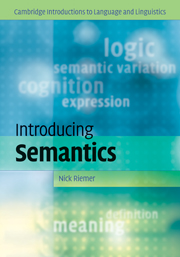Book contents
- Frontmatter
- Contents
- Note to the reader
- 1 Meaning in the empirical study of language
- 2 Meaning and definition
- 3 The scope of meaning I: external context
- 4 The scope of meaning II: interpersonal context
- 5 Analysing and distinguishing meanings
- 6 Logic as a representation of meaning
- 7 Meaning and cognition I: categorization and cognitive semantics
- 8 Meaning and cognition II: formalizing and simulating conceptual representations
- 9 Meaning and morphosyntax I: the semantics of grammatical categories
- 10 Meaning and morphosyntax II: verb meaning and argument structure
- 11 Semantic variation and change
- Glossary
- References
- Index
5 - Analysing and distinguishing meanings
Published online by Cambridge University Press: 05 June 2012
- Frontmatter
- Contents
- Note to the reader
- 1 Meaning in the empirical study of language
- 2 Meaning and definition
- 3 The scope of meaning I: external context
- 4 The scope of meaning II: interpersonal context
- 5 Analysing and distinguishing meanings
- 6 Logic as a representation of meaning
- 7 Meaning and cognition I: categorization and cognitive semantics
- 8 Meaning and cognition II: formalizing and simulating conceptual representations
- 9 Meaning and morphosyntax I: the semantics of grammatical categories
- 10 Meaning and morphosyntax II: verb meaning and argument structure
- 11 Semantic variation and change
- Glossary
- References
- Index
Summary
CHAPTER PREVIEW
The different sections of this chapter follow three logical steps in meaning analysis. In 5.1, some of the different possible semantic relations among words are exemplified and discussed. We concentrate on those relations which are of most use for semantic description:
antonymy (oppositeness; 5.1.1),
meronymy (part of-ness; 5.1.2),
the class-inclusion relations of hyponymy and taxonomy(kind of-ness; 5.1.3-4) and
synonymy (5.1.5).
These meaning relations can be seen as reflecting the presence of various isolable components in the meanings of the related words; accordingly, Section 5.2 introduces the possibility of analysing senses as composed of bundles of semantic components, and considers the wider applicability of componential analysis as well as the problems it faces. The third section (5.3) discusses the necessity for a theory of meaning to specify the number of senses associated with a lexeme in a rigorous way. In 5.3.1 we distinguish the case where a single lexeme possesses several related meanings (polysemy) from two other cases: the case where it possesses only a single meaning (monosemy) and the case where it possesses two unrelated meanings (homonymy). Section 5.3.2 then shows that any attempt to make these definitions rigorous confronts serious problems, the implications of which are discussed in 5.3.3.
Lexical relations
Knowing an expression's meaning does not simply involve knowing its definition or inherent semantic content. As well as knowing a word's definitional meaning, a competent speaker knows how it relates to other words of the language: which words are synonyms? Which are antonyms?
- Type
- Chapter
- Information
- Introducing Semantics , pp. 135 - 172Publisher: Cambridge University PressPrint publication year: 2010



